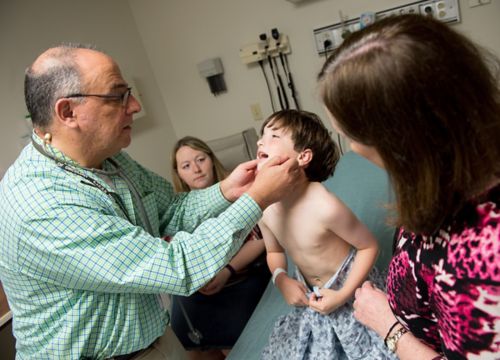Menu
Close
Back
Welcome to
Together is a new resource for anyone affected by pediatric cancer - patients and their parents, family members, and friends.
Learn MoreWhen doctors suspect an infection in a childhood cancer patient, they may need to find out what germ is causing the infection. Knowing the source of infection can help doctors determine an appropriate treatment.
An infection can be life-threatening for patients. Certain cancers and treatments can severely damage the immune system, leaving patients vulnerable to serious infections.
Figuring out the source of infection may require certain tests and procedures. The specific type depends on the patient’s signs and symptoms and what type of infection doctors suspect.
Because of the critical nature of infections, doctors may immediately begin a broad-spectrum antimicrobial treatment plan that can kill or stop the growth of a wide range of germs – even before the care team begins tests and procedures to pinpoint the cause of the infection.

If an infection is suspected, health care providers generally start with a medical history and physical exam, which may be followed by tests to find more information.
Health care providers generally start by taking a detailed medical history and performing a physical examination. They are looking for signs and symptoms that indicate the site of infection. These may include, but are not limited to:
After the examination, providers may order certain tests to gather more information.
Blood culture is the most common test to diagnose infection. It involves drawing blood from the patient and sending the blood sample to the laboratory.
Additional tests may be run depending on the patient’s signs and symptoms.
If a urinary infection is suspected, the care team will collect a urine specimen from the patient and perform urine tests such as urine culture and/or urinalysis.
If the patient has respiratory symptoms such as coughing or a runny nose, doctors may perform a nasopharyngeal (nay zo fa RIN jee ul) wash or swab. This is done to obtain a sample of cells and secretions from the space behind the throat connected to the nasal passage. This space is called the nasopharynx.
In some cases, doctors may also order additional tests and procedures such as a chest X-ray, CT scan or bronchoscopy to check for sources of infection.
If doctors see signs of skin infection, they may perform a skin biopsy of the abnormal skin area to look for causes infections.
If a wound shows signs of infection, doctors will collect liquid from the wound and send it to the lab for testing.
To perform a wound culture, a member of the care team will clean the wound, collect fluid from the wound using a swab, place it in a culture preparation, and send to the lab.
If a patient has signs and symptoms such as diarrhea, a stool specimen may be collected for culture or other types of tests.
A fresh stool sample must be collected in a clean container that has not been contaminated with other substances such as urine, water, or by touching the toilet or diaper. Once the sample has been collected, it will be taken to a laboratory. A stool sample may also be collected with a swab of the rectum.
Doctors may order a CT of abdomen and pelvis to look for signs of infection.
If doctors suspect a CNS infection, they may order a lumbar puncture test or imaging studies such as brain MRI.
At times, all test results may come back as negative. That means the type of the germ causing the infection could not be identified. If an infection is still suspected, doctors may, upon review, continue to use an antimicrobial treatment plan that is effective against most possible causes of the infection.
If the germ causing the infection is detected growing on cultures, a susceptibility test may be performed. These tests determine if the germ will be susceptible or resistant to different antibiotics. The care team will use the results of these tests to determine the most appropriate treatment.
It takes at least 24 hours and perhaps 2-3 days (or more) to get test results, depending on the type of test.
The care team will share the results with the family and discuss treatment options.